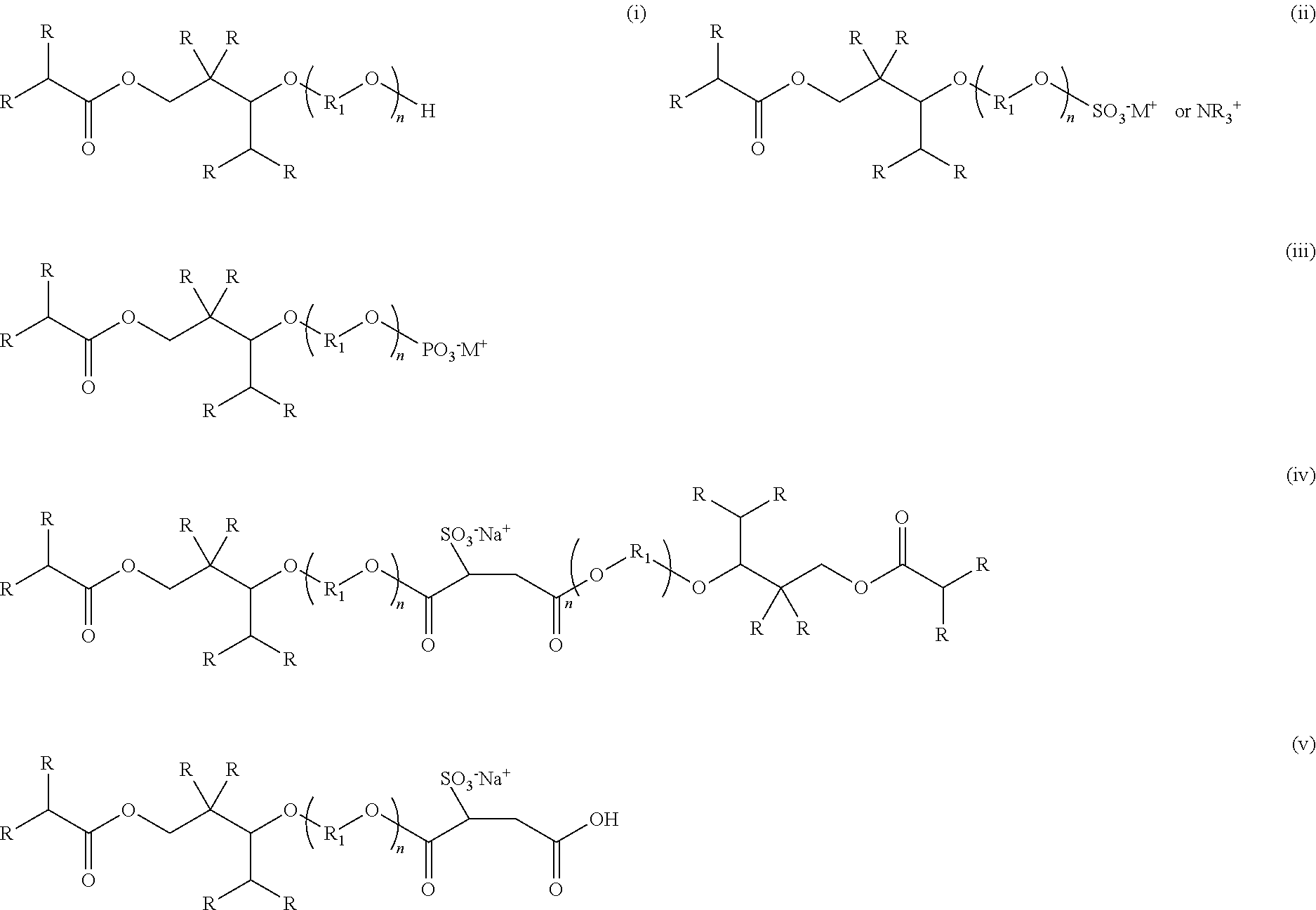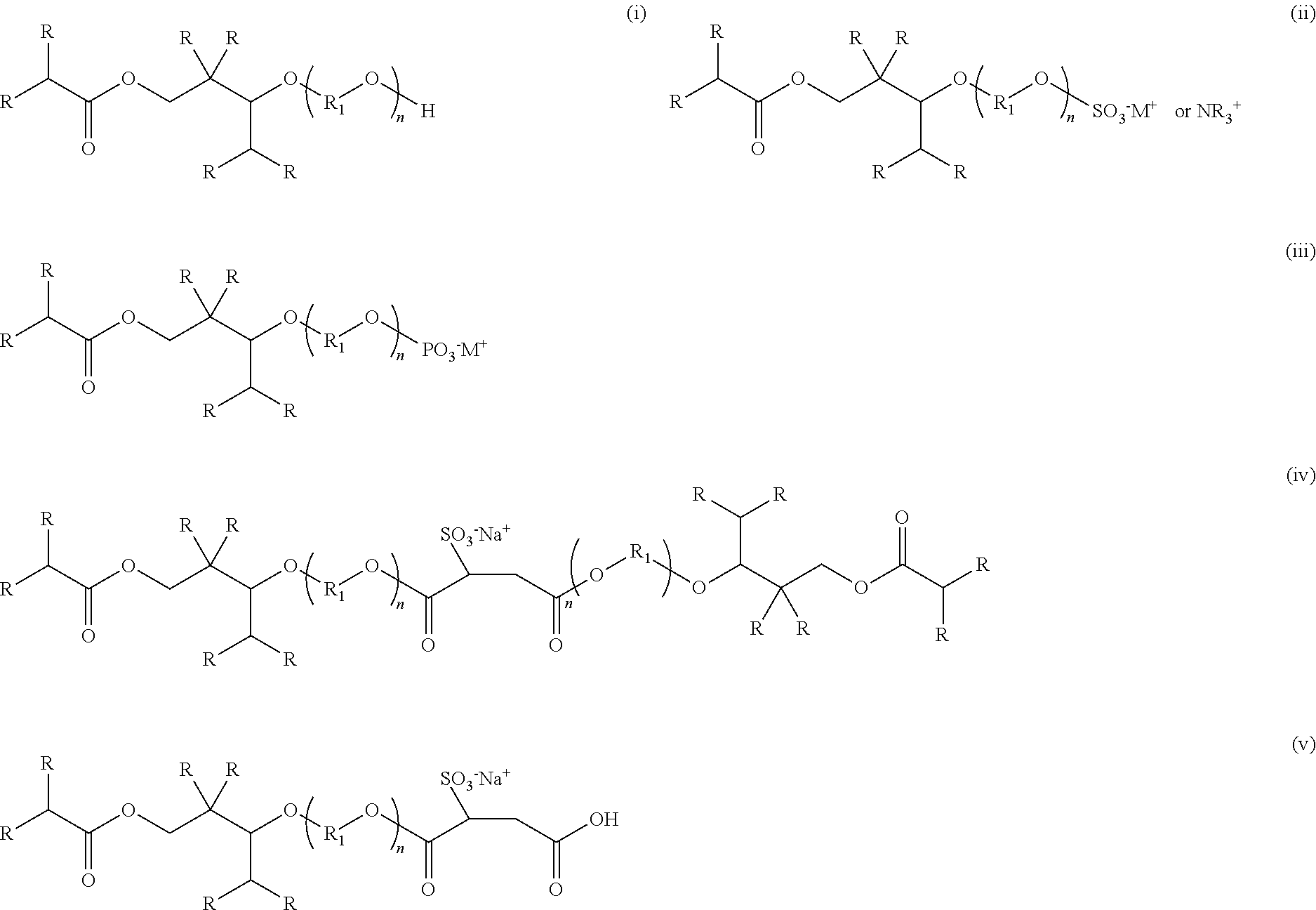Dispersants
a technology of dispersants and liquid media, applied in the field of dispersants, can solve the problems of nullifying the work earlier done, requiring high mechanical forces, and not being able in most cases to build, and achieve excellent levelness and covering power, high tinctorial strength and brilliance.
- Summary
- Abstract
- Description
- Claims
- Application Information
AI Technical Summary
Benefits of technology
Problems solved by technology
Method used
Image
Examples
example 1
[0083]Anionic compositions of formula (ii) were synthesized by the following general method. 500 g of 2,2,4-trimethyl-1,3-pentanediol monoisobutyrate or alkoxylated 2,2,4-trimethyl-1,3-pentanediol monoisobutyrate were charged to a 1 L four-neck round-bottom flask equipped with an overhead stirrer, nitrogen inlet, and thermocouple. 0.1% dicyandiamide was then charged to the reaction flask. The reaction mixture was heated to 80° C. and 0.9 eq. Sulfamic acid was slowly added. The reaction mixture was held at 100° C. for 2 hours and the reaction mixture was allowed to cool to 50° C. Deionized water was added to produce a 50% solution of the ammonium salt of the sulfated ester alcohol. Neutralization with potassium or sodium hydroxide yields the corresponding alkali metal salt. The sulfated ester alcohol and sulfated alkoxylated ester alcohols exhibited excellent wetting of a variety of substrates and produced very low foam.
example 2
[0084]Anionic compositions of formula (iii) were synthesized by the following general method. 500 g of 2,2,4-trimethyl-1,3-pentanediol monoisobutyrate or alkoxylated 2,2,4-trimethyl-1,3-pentanediol monoisobutyrate were charged to a 1 L four-neck round-bottom flask equipped with an overhead stirrer, nitrogen inlet, and thermocouple. The reaction mixture was heated to 80° C. and 0.33 eq. Phosphoric anhydride was slowly added to produce an equimolar mixture of mono and diester. The reaction mixture was held at 100° C. for 2 hours and the reaction mixture was allowed to cool to 50° C. Deionized water was added to produce a 50% solution. Neutralization with potassium or sodium hydroxide yields the corresponding alkali metal salt. The phosphated ester alcohol and phosphated alkoxylated ester alcohols exhibited excellent wetting of a variety of substrates and produced very low foam.
example 3
[0085]Anionic compositions of formula (iv) and (v) were synthesized by the following general method. 500 g of POE(3) 2,2,4-trimethyl-1,3-pentanediol monoisobutyrate were charged to a 1 L four-neck round-bottom flask equipped with an overhead stirrer, nitrogen inlet, and thermocouple. The reaction mixture was heated to 80° C. and either 1 eq. or 0.5 eq. maleic anhydride was charged slowly. The reaction mixture was held at 100° C. for 2 hours and the reaction mixture was allowed to cool to 50° to yield either the mono or diester of the alkoxylated 2,2,4-trimethyl-1,3-pentanediol monoisobutyrate and maleic anhydride. The sulfonated dispersants were synthesized by subjecting the mono or diesters of the alkoxylated 2,2,4-trimethyl-1,3-pentanediol monoisobutyrate and maleic anhydride to a standard sulfonation reaction using sodium bisulfite and subsequent addition of dionized water to form a 50% solution. The sulfonated mono or diesters of the alkoxylated 2,2,4-trimethyl-1,4-pentanediol m...
PUM
| Property | Measurement | Unit |
|---|---|---|
| diameters | aaaaa | aaaaa |
| diameters | aaaaa | aaaaa |
| diameters | aaaaa | aaaaa |
Abstract
Description
Claims
Application Information
 Login to View More
Login to View More - R&D
- Intellectual Property
- Life Sciences
- Materials
- Tech Scout
- Unparalleled Data Quality
- Higher Quality Content
- 60% Fewer Hallucinations
Browse by: Latest US Patents, China's latest patents, Technical Efficacy Thesaurus, Application Domain, Technology Topic, Popular Technical Reports.
© 2025 PatSnap. All rights reserved.Legal|Privacy policy|Modern Slavery Act Transparency Statement|Sitemap|About US| Contact US: help@patsnap.com



